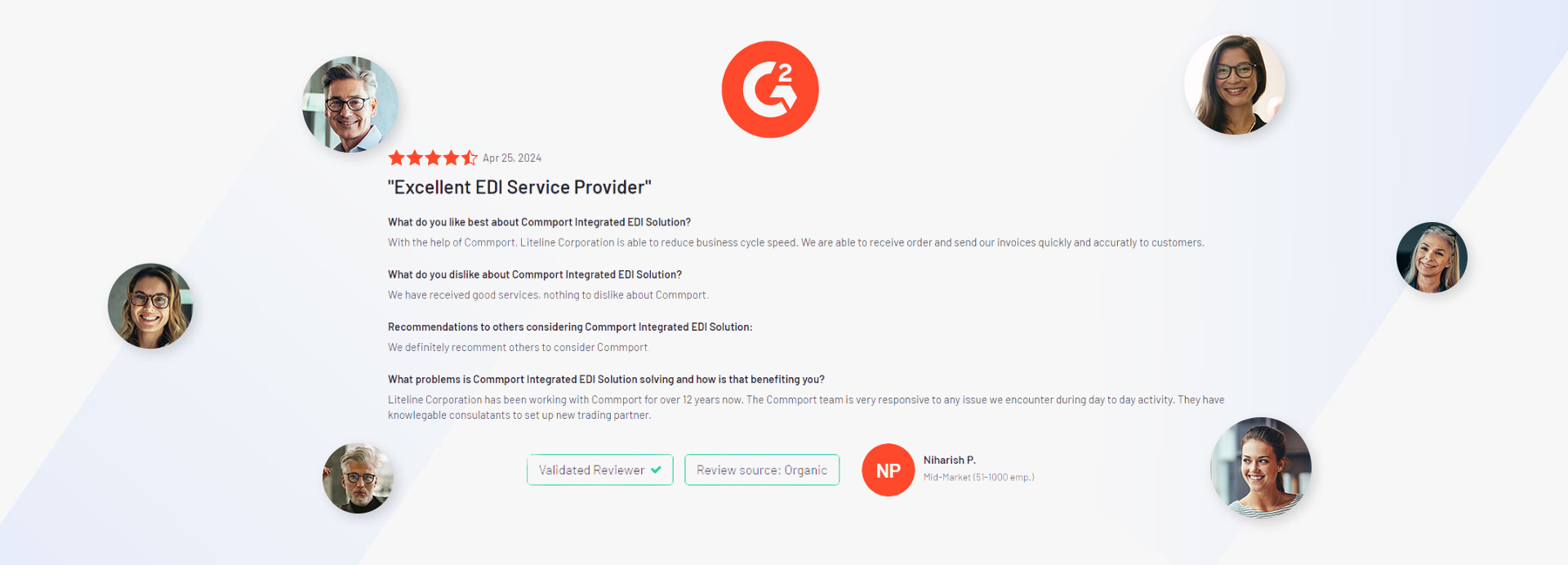EDI is a structured electronic communication method that enables the exchange of business documents and information with trading partners without the need for human intervention. EDI replaces the traditional paper-based processes involved in business transactions, such as purchase orders, invoices, shipping notices, etc., and replaces them with standardized electronic documents.

Manual data entry can lead to slower order fulfillment and increase operational expenses by 20-30%, + up to an additional 20% in chargebacks due to data processing errors.
Are you struggling with manual processes, integration issues, or visibility gaps in your operations? Here are some common problems businesses face without an EDI solution:
Inconsistent quality, accuracy issues, and frequent manual entry mistakes.
High processing costs, delays in order fulfillment, and time-consuming reconciliation.
Compatibility challenges with diverse partner systems and communication protocols.
Lack of real-time updates and insight into transactions, inventory, and shipments.
Data inaccuracies or misalignment can cause significant delays.
Poor tracking and monitoring of transaction status hampers decision-making.
These challenges don’t just slow you down—they cost you time, money, and trust! Commport EDI eliminates these problems with seamless integration, real-time visibility, and automated processes designed to simplify your operations and drive efficiency.
Commport EDI facilitates efficient data exchange, enabling businesses to effectively collaborate with partners and automate critical business processes.

Commport’s EDI solutions enable businesses to establish secure and direct connections with their trading partners, eliminating the need to run on-premise EDI translation software and reducing communication costs.
Commport offers both integrated EDI and cloud-based EDI solutions. Our EDI solutions facilitate the electronic exchange of business documents between trading partners. It enable businesses to transmit documents such as purchase orders, invoices, shipping notices, and other transactional information electronically, in a standardized format. The solutions include document mapping, translation, validation, and communication protocols.
Commport’s integrated EDI integrates with all ERP (Enterprise Resource Planning) systems, and other business applications, such as inventory management, order processing, and shipping systems, creating a seamless flow of information between different departments and systems. Commport supports EDI standards such as ANSI X12, EDIFACT, EANCOM, RosettaNet, ODETTE and TRADACOMS, providing businesses with a secure and efficient means of exchanging information with their trading partners.
Commport’s cloud EDI solution leverages the power of the Internet, empowering small businesses to exchange ANSI X12 documents with their trading partners using a web-browser.
Unlock the full potential of your supply chain with our comprehensive EDI Buyer's Guide — your first step towards seamless, efficient, and error-free transactions
Commport's EDI Solutions streamline business communications by seamlessly connecting trading partners, automating data exchange, and enhancing supply chain efficiency. With Commport’s robust EDI platform, you gain real-time visibility into transactions, simplified compliance with trading partner requirements, and secure data exchange across industries. Our solution supports multiple EDI formats, offering flexible integration with your existing systems for a customized experience that grows with your business. Backed by dedicated support and expertise, It ensures your data flows smoothly, helping you reduce costs, avoid errors, and improve overall productivity.
What are the differences between Commport Integrated and Cloud EDI Solutions, and which one is right for you?
Well, Integrated EDI and cloud-based EDI are two different approaches to implementing electronic data exchange between business partners. It all comes down to 6 key differences and depending on your requirements you can choose the right solution that fits your business needs.
Commport offers a number of EDI solutions to help you increase your business efficiencies

Integrate with your internal management system such as ERP, automating the processing of your EDI messages.

Empowers you to begin exchanging EDI with your trading partners today… all you need is an internet connection!

Let Commport manage ALL aspects of your EDI relationships for you (trading partners/retail partners, etc.)




Discover the transformative impact of our EDI, CPS, and VAN solutions through the powerful testimonials of satisfied clients who have experienced remarkable results with Commport products and services.








EDI stands for Electronic Data Interchange which is the exchange of large amounts of information computer-to-computer in a specified format between business partners.
Electronic Data Interchange (EDI) is defined as the electronic communication process for exchanging data amongst trading partners without human intervention. Simply put, EDI provides a technical basis for commercial “conversations” between two entities, either internal or external.
EDI compliance refers to a business’s capacity to accurately send and receive EDI transactions according to the order data requirements of its EDI trading partners. Each document must adhere to a specific EDI format to ensure the successful exchange of EDI documents.
EDI communication standards are the requirements for the format and composition of EDI documents. EDI standards delineate the correct order and location of units of data in each EDI document.
The main difference between EDI and simply sending email with EDI information, is the set of rigorous standards involved with following the EDI format. These standards were put in place to ensure that companies who use EDI as their method of information transfer were being diligent about security, and conforming to the proper procedures of the protocol.
The other difference, is that EDI is for the most part handled by computer systems; human intervention is usually only required when there are errors to address. In this way, it needs to follow a seamless data transfer process by which the data set being sent to the receiving machine is accepted and confirmed with no down-time.
Over time, EDI and the web began to live harmoniously. In fact, those businesses that have used EDI as their data transfer methodology have leveraged the Internet to send their EDI documents, instead of what some thought would happen: the Internet replacing EDI. If anything , the Internet has simply facilitated the transfer of EDI documents.
EDI has been used in the past primarily by automotive and retail businesses, however in the past few years, the format has been more widely adopted across many industries. Manufacturing, healthcare, banking, government organizations, pharmaceutical, utility, construction companies & more.
Basically, any type of business that deals with large amounts of identical paperwork/form data can directly benefit from adopting an EDI solution. The benefits of EDI over using a paper system are clear:
“EDI solutions (Electronic Data Interchange) are designed to help you manage this massive amount of paperwork. The considerations for savings in time, potential errors from mistyped or incorrectly logged information, not to mention the impact on the environment—all of these are important considerations when you’re looking into an Edi solution for your business.
If your business model is based on having a series of processes that are labour intensive—yet completely necessary—in regards to a huge amount of work required to keep things running, then you will want to consider an EDI solution.”
First of all, lay out your process for handling documents from one side of the chain to the next. What is the process? Does it require a great amount of manual intervention? Think of how many places in the process where a human agent is necessary to move the process to the next stage.
Think about how much variation exists between documents. Consider that with an EDI solution, there should be seamless migration from one system to another. The less human intervention required, the better the system will perform.
Next, identify your internal network. What are you currently using to move your processes forward? How would you benefit from having an EDI solution in place? What would it replace? Have you considered the time and energy considerations for implementing an EDI solution?
Plan out your workflow. Once your documents have been brought to a certain level, how are they to be passed to the next stage?
Once you have identified these steps, you will be that much more prepared to integrate an EDI solution to manage a lot of the legwork currently going into your document tracking and submitting process.
What type of infrastructure do you need to have in place? The great thing about modern EDI solutions (Commport offers several solutions, including EDI software solutions like CyberLiNK) you do not have to have more than an Internet connection and the proper software installed to make use of the many advantages of EDI. The nature of Commport’s solutions is to apply optimum security right out of the gate, so you don’t even have to think about it.